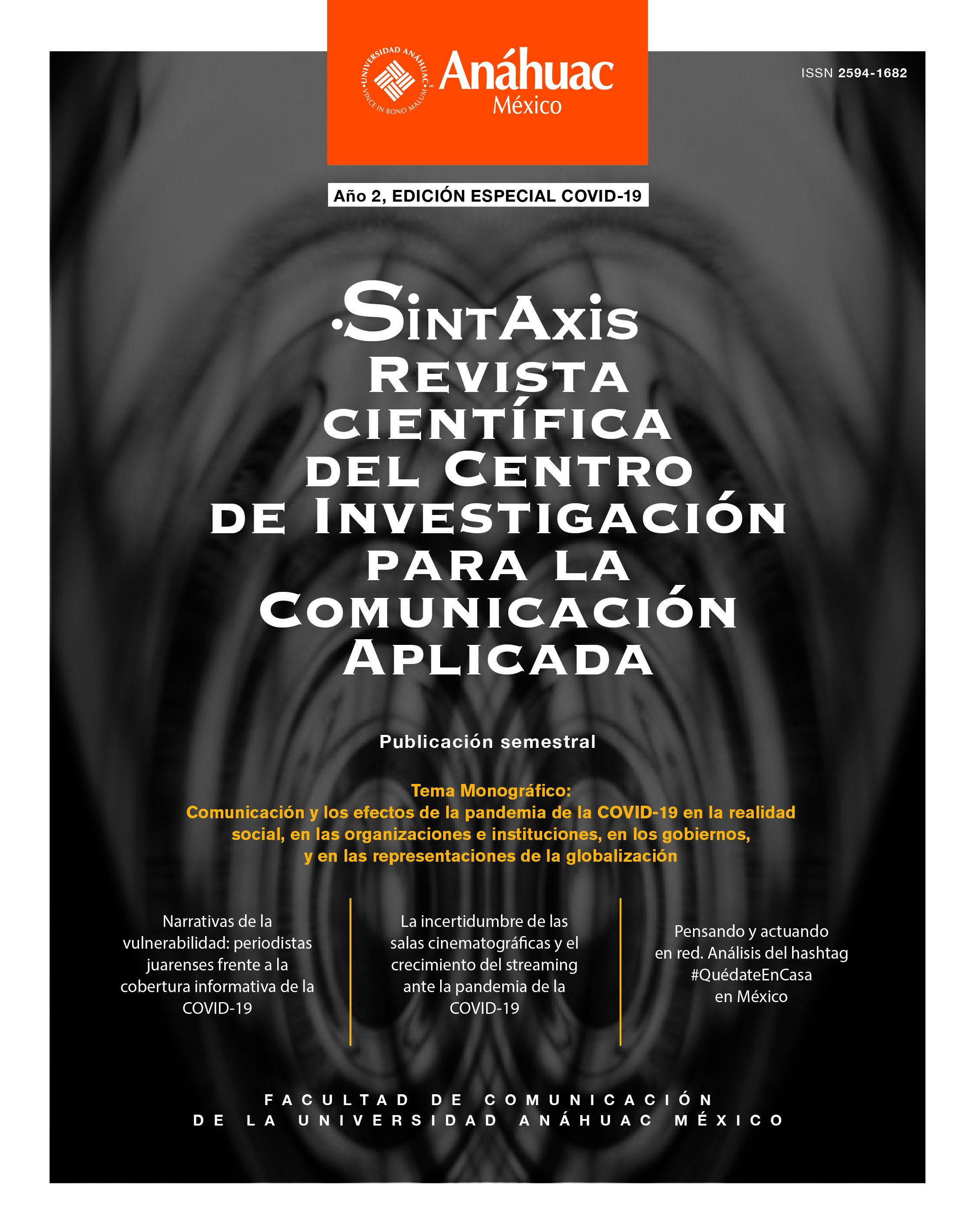Narratives of vulnerability: journalists from Juarez in the informative coverage of the COVID-19
Main Article Content
Abstract
The article presents the first findings of a qualitative exploratory study on the experiences of journalists in the news coverage by COVID-19 in Ciudad Juárez. From semi-structured interviews, the planning processes, the role of journalism in emergency contexts, as well as the impacts (labor and emotional) of coverage in a printed newspaper, El Heraldo de Juárez and another digital, Norte, are analyzed in a comparative way. The results show that in emergency contexts: a) the use of virtual platforms for remote work is essential in the organization of editorial work, b) distance restrictions affect journalistic work and direct exchange with the authorities, c) In the context of the health crisis, journalists are concerned about job uncertainty, the risk to their health and the emotional impacts of coverage.
Downloads
PLUMX Metrics
Article Details
The author keeps the property rights with no restriction whatsoever and guarantees the magazine the right to be the first publication of the work. The author is free to deposit the published version in any other medium, such as an institutional archive or on his own website.
References
Bernabé, J. (2007). Orígenes, principios, objetivos y herramientas del periodismo preventivo. (Bernabé, Javier, ed.). Periodismo preventivo. Otras maneras de informar sobre las crisis y los conflictos internacionales (pp. 17-33). Madrid, Catarata.
Camps, S. (1999). Periodismo sobre catástrofes. México, Ediciones Paulinas.
Checa, A. (2008). Ciudad Juárez: feminicidios, sociedad y medios (Checa Godoy y M. Ramírez Alvarado, eds.). Visiones de América: Comunicación, mujer e interculturalidad
(pp. 193-211). Netbiblo.
Domínguez-Panamá, J. J. (2017). El periodismo de desastre: de las no-rutinas a las funciones sociales del periodista. Comhumanitas: revista científica de comunicación, 8(1). https://doi.org/10.31207/rch.v10i2.206
Hight, J., & Smyth, F. (2003). Tragedias & Periodistas. Guía para una cobertura más eficaz. Dart Center for Journalism/Trauma and Columbia University.
Márquez, M., & Sallie, H. (2016). Panorama de los perfiles demográficos, laborales y profesionales de los periodistas en México. Global Media Journal, 14(26).
Olsson, E. (2010). Defining crisis news events. Nordicom Review, 31(1). https://doi.org/10.1515/nor-2017-0122
Oyandel, R., & Alarcón C. (2010). Reflexiones y desafíos: Una mirada al tratamiento televisivo de la catástrofe. Cuadernos.info, (26), 115-122. https://doi.org/10.7764/cdi.26.16
Reyna, A. (1998). Algunas contribuciones de la demografía al estudio de los desastres. (Garza Salinas, M. & D. Rodríguez, coords.). Los desastres en México. Una perspectiva multidisciplinaria (pp. 39-58). México, UNA M/UIA/UAM-X.
Rodríguez, P., & Odriozola, B. (2010). Catástrofes y periodismo: el relato, los escenarios, las interacciones y las necesidades prácticas y psicológicas de todos los implicados. Estudios sobre el Mensaje Periodístico, 18(2). https://doi.org/10.5209/rev_esmp.2012.v18.n2.41033
Rodríguez, R., & Martín M. (2003). Periodismo de catástrofes: el 11 de septiembre. Análisis del suceso y experiencias vividas. Ámbitos, (9-10). https://doi.org/10.12795/ambitos.2003.i09-10.30
Segob & Cenapred. (2006). Conceptos básicos sobre peligros, riesgos y su representación geográfica.Shih, T., Wijaya, R., & Brossard, D. (2008). Media Coverage of Public Health Epidemics: Linking Framing and Issue Attention Cycle Towards an Integrated Theory of Print News Coverage of Epidemics. Mass Communication & Society, 11(2). https://doi.org/10.1080/15205430701668121
Toledano, S., & Ardèvol-Abreu, A. (2013). Los medios ante las catástrofes y crisis humanitarias: propuestas para una función social del periodismo. Communication & Society/ Comunicación y Sociedad, 26(3).
Waisbord, S. (2010). Cuando la salud es titular: dengue, gripe AH1N1 y ciclos ‘mediático-epidémicos’. Folios, 23.

